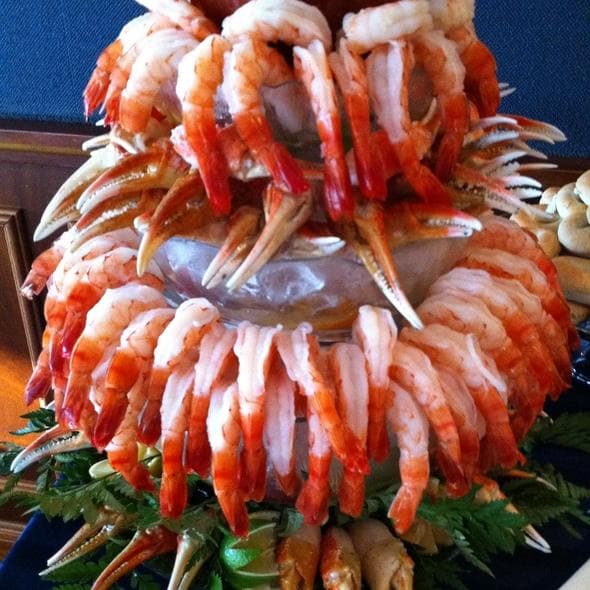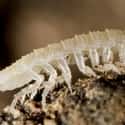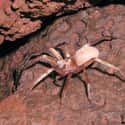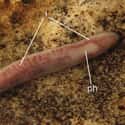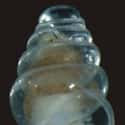-
(#1) The Tobini Cave Millipede Turned Four Of Its Legs Into Penises
Illacme tobini was discovered in October 2016 by cave biologist Ben Tobin of the National Park Service, found living deep underground in dark marble caves in Sequoia National Park in California. This creature has some really bizarre adaptations to subterranean life. While its closest relative, the Illacme plenipes, has 750 legs, Illacme tobini only has 414 legs. Additional modifications to cave life include strange mouthparts, four legs that have turned into penises, silk-secreting hairs, and nozzles on every segment that squirt a defensive chemical that is still a mystery.
-
(#2) Texas Blind Salamander
- Eurycea rathbuni
The Texas blind salamander is a highly specialized salamander species only found in the water-filled caves of Hays County, TX. The top predators in their niche environments, the Texas blind salamander has adapted to total darkness so well that it no longer has eyes, only two black spots where eyes would normally be. It does not need pigment to protect its skin from sunlight or for camouflage, so its skin is translucent and ghostly white. The US Fish & Wildlife Service has classified them as endangered because of their restricted range and the threat of water pollution.
-
(#3) Tailless Whip Scorpions Have Crazy Legs To Move Around Dark, Dank Caves
The tailless whip scorpion, also known as the cave spider, is neither scorpion nor spider, but its own order of arachnid called Amblypygi. Tailless whip scorpions look terrifying, but they are not venomous and pose no threat to humans. Their bodies have developed to be low to the ground so they can stick closely to cave walls and fit through narrow cracks. They have poor eyesight, but make up for it with highly-modified front legs that grow extremely long and act as feelers to help it hunt for food in the dark subterranean environments they call home. Unlike other arachnids, which are largely solitary and primarily concerned with hunting, tailless whip scorpions have adapted to the lack of space in suitable caves by becoming less aggressive and territorial, allowing colonies of them to live together without cannibalizing each other.
-

(#4) Phantom Cave Snails Are Completely White - Unlike Their Non-Cave Relatives
Phantom cave snails are cave-dwelling relatives of freshwater gastropods known as springsnails, native to a small series of caves in the vicinity of Balmorhea, TX. Like many subterranean creatures, phantom cave snails are blind and have abandoned the use of pigment in their bodies so they appear pale white or transparent. They also have more convex shell whorls than their terrestrial relatives, longer umbilicus, and a simple penis. Due to their existence being dependent upon three small springs, the phantom cave snail is considered to be a critically imperiled species.
-

(#5) Grand Canyon Pseudoscorpions Have No Stinging Tail
Scientists were amazed when two new species of pseudoscorpions - ancient relatives of scorpions that lack tails with venomous stingers - were discovered living in the same caves in the Grand Canyon. It is rare for two related species of predators to co-exist in a single cave system, so scientists think the cave must have a robust ecosystem with ample food. Named Hesperochernes bradybaughii and Tuberochernes cohni, the two species of arachnids have adapted to the lack of a stinging tail by having venomous stingers in their pincers. They retain limited use of their eyes, but have lost much of their bodily pigmentation.
-
(#6) The Mexican Blind Cavefish Looks Different Than Its Fish Relatives, But Can Still Reproduce With Them
Found in caves throughout Mexico and the southern United States, the Astyanax mexicanus, commonly called the Mexican blind cavefish, can co-exist with and still reproduce with its surface-water relatives, even though it has become heavily mutated and modified from years in total darkness. To conserve energy, Mexican blind cavefish have lost their eyes and the vision center of their brains, as well as their pigmentation; their scales have become translucent. The Mexican blind cavefish have adapted to being blind by having taste buds that grow on the outside of their lower jaws, which help them taste the water around them for food.
-
(#7) The Cave Woodlouse Has Zero Pigment Or Eyes
The cave woodlouse was found in a pretty crazy place - a cave that was isolated for more than 5 million years. The cave, located in southeastern Romania near the Black Sea, has one the rarest ecosystems in the world. That's because it's been undisturbed by outside influences, including sunlight, for so long that the creatures within have developed some pretty unusual adaptations. It's hot and humid in the cave, low in oxygen, and the water at the bottom is warm and sulphidic, giving the cave a putrid, rotting eggs smell. A human being could only survive in the cave without breathing apparatus "for five or six hours before their kidneys" shut down.
The cave is covered by a thick layer of clay that prevents fresh water from seeping down into it, but the environment is perfect for the growth of a type of bacteria called "autotrophs" that grows in large floating mats of frothy foam atop the fetid water. And another bacteria called "methantrophs" that derives energy and carbon from methane gas bubbles. All creatures in the cave system feed off of this bacteria, including the cave woodlouse, which has adapted to life in total darkness by sacrificing its pigmentation - there's no need for camouflage or sexual displays in the dark - and its eyes.
-
(#8) Unlike Their Land-Dwelling Relatives, Kaua'i Cave Wolf Spiders Have No Eyes
This native of Hawaii was discovered in 1973, and has since then only been found living in a few caves in the Koloa District of Kaua‘i. The cave wolf spider is closely related to wolf spiders that dwell on land above it, but whereas the surface-dwellers have large eyes and acute vision, the cave-dwellers have lost their eyes completely. They don't need physical camouflage to hide from prey so they have lost much of their pigmentation. They are venomous, but only dangerous to small prey animals. The cave species is endangered due to its limited habitat, but the US Fish & Wildlife Service started a 34-acre preserve to protect the population.
-
(#9) Hausera Hauseri Use Specialized Hairs To Get Around, Unlike Their Flatworm Ancestors
Hausera hauseri is the first cave-dwelling species of planarian (flatworms) discovered in South America. While most flatworms have two eyes or even two pairs of eyes (one set being sub-eyes), the Hausera hauseri's eyes have disappeared and been replaced with ciliated sensory cells, specialized "hairs" that help it navigate its environment and seek out food. Like many cave-dwelling species, the Hausera hauseri has little pigmentation and is virtually colorless. The species is still so new to science that little else is known about its life and functions.
-

(#10) Brazilian Cave Beetles Have Modified Body Parts To Survive Life In The Dark
Coarazuphium caatinga, or Brazilian cave beetle, were discovered in 2014, and it has many unique traits adapted for living in underground limestone caves. The bodies of the cave-dwelling variant of the beetle are more tapered than their surface-dwelling relatives. They have retained their eyes, but they are smaller and less functional. To make up for their poor eyesight, the cave beetles have developed "extra-optic sensory structures," hairs modified to sense movement. They also have modified mandibles and other sensilla (modified hairs) that are still being researched and have lost much of their bodily pigmentation.
-

(#11) Braken Bat Cave Meshweavers Love Hot, Damp Caves
The Braken Bat Cave meshweaver spider was first discovered living in a cave in Bexar County, TX, in 1980. The species was not seen again until 2012, when a highway construction crew in San Antonio unearthed a six-foot deep natural hole in the median. The species had been presumed extinct so its rediscovery was heralded as the "eight-legged discovery of the millennium." The species, which thrives in caves because of the consistent temperature and humidity, are blind and colorless, unlike their terrestrial cousins.
-

(#12) The Cave Planthopper Cannot Fly, As Its Wings Are Merely Ornamental
Discovered living in a single cave with a single small opening in the Iuiú municipality, Bahia, Brazil, this cave planthopper has developed differently than its relatives living in the jungle above. Like most troglobites, the cave planthopper, whose scientific name is Iuiuia caeca, lost its eyes and has very little pigmentation, giving it a pale yellow translucent appearance. Since flying is a high-energy activity, the cave planthopper has also sacrificed its ability to fly and has only non-functional wings.
-
(#13) The Transparent Snail Has A See-Through Shell
This cave-dwelling gastropod was discovered in 2012. It's blind and has a transparent body just like the phantom cave snail; however, it has also adapted to cave life by eliminating pigment in its shell. Discovered living more than 3,000 feet (914 meters) beneath the ground in a cave in Croatia, the transparent snail has also adapted to the lack of nutrients at those depths by being an incredibly slow mover, even for snails. They "only creep a few millimeters or centimeters a week, and mainly in circles, grazing" in the same place.
-

(#14) Bristly Cave Crayfish Don't Have The Usual Markings Of Other Crayfish
Along with two, possibly three, other species of cave-dwelling crayfish that live in the subterranean waters of the Missouri east-central Ozarks, the Bristly Cave crayfish lack pigmentation and are ghostly white. Without light, the colors and patterns that would normally serve as camouflage are useless and the crayfish conserve energy by not producing pigment. Their vision is very poor, but they have modified bristles on their legs and pincers that serve as sensory organs that help the crayfish navigate in darkness, as well as extra-long antennae.
-
(#15) Cave Loach Are Half The Size Of Their Surface Friends
While there are an estimated 200 species of cave-dwelling fish around the world, cave loach living in the Danube-Aach cave system in Southern Germany is the first ever instance of a troglophilic fish in Europe. It is believed the cave loach separated from its terrestrial relatives as many as 20,000 years ago. The cave loach's body is similar in structure to a surface loach except that much of its pigmentation has disappeared, giving it a translucent pink hue. The cave loach has retained its eyes, but they shrunk to half the size of a surface loach and "they don't react" to light, so scientists are not even sure they are functional.
New Random Displays Display All By Ranking
About This Tool
The hidden and deep caves have unique environmental conditions that make the life of creatures mysterious and challenging. Many cave environments are in constant darkness and high humidity, and it is difficult for animals to absorb nutrients and even full of gases such as sulfur and methane mixtures that are lethal to most organisms. However, there are still many cave-dwelling creatures who have evolved and adapted to live in these gloomy, dark environments.
Insects, fish, and crustaceans can penetrate into mysterious caves all over the earth, perhaps the most well-known cave dwellers are bats. Here the random tool introduced 15 fascinating skills of cave-dwelling creatures.
Our data comes from Ranker, If you want to participate in the ranking of items displayed on this page, please click here.

